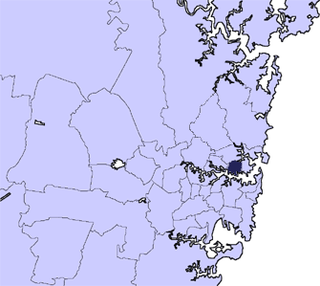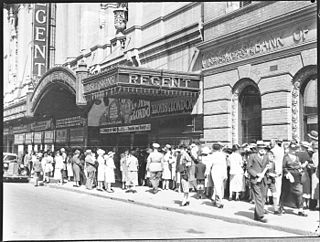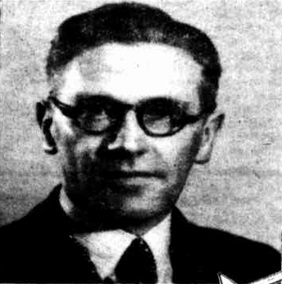
Cremorne is a suburb on the Lower North Shore of Sydney, New South Wales, Australia, located 6 kilometres north-east of the Sydney central business district, in the local government area of North Sydney Council.

Capertee is a village 45 km north of Lithgow, New South Wales, Australia. It is on an elevated site above the Capertee Valley. In 2016, the township had a population of 145 people. The Castlereagh Highway links Capertee with Lithgow to the south and Mudgee to the north. The township is surrounded by National Parks and grazing land. Principal employment is in coal mining, farming and tourism-related services. The Capertee Valley forms a part of the catchment area of the Hawkesbury River, but the village lies very close to the Great Divide watershed, with the Turon River catchment nearby to its west.

North Sydney Council is a local government area on the Lower North Shore of Sydney, New South Wales, Australia, established on 29 July 1890 through the amalgamation of three boroughs.

The Regent Theatre was a heritage-listed cinema and entertainment venue in George Street, Sydney, New South Wales, Australia, built in 1928 as a flagship for Hoyts, and was demolished in 1988 by property developer Leon Fink.
Michael Hayden Walsh, is an Australian former Gold Logie winning radio and television presenter, currently focused on owning and operating live theatres. His current career includes theatre production in London and Australia. Walsh was the first "King of Australian Daytime TV", with his program The Mike Walsh Show, featuring both local and international guests, including Hollywood performers.

The Sydney County Council (SCC) was formed in 1935 to produce electricity and operate the electricity network in a number of municipalities in metropolitan Sydney. Unlike other New South Wales county councils, which were voluntary associations of local councils to undertake local government activities permitted or required of them by the Local Governnment Act 1919, Sydney County Council was established under a separate piece of legislation by the state government to perform the electricity distribution and streetlighting operations of the local government areas concerned. On its establishment it assumed control of the Electricity Department of the Sydney City Council, which was already supplying electricity to other municipalities. In 1952, the SCC lost most its electricity generation functions to the Electricity Commission of New South Wales and retained only its distribution functions. The SCC was merged with other municipal county councils in 1990 to form Sydney Electricity.

Samuel Robert Nicholls was an Australian politician. He was an Australian Labor Party member of the Australian House of Representatives from 1917 to 1922, representing the electorate of Macquarie.

The Criterion Theatre was a theatre in Sydney, Australia which was built in 1886 by architect George R Johnson on the south east corner of Pitt and Park streets. It closed in 1935 and the building was demolished.
The Coonabarabran Shire was a local government area in the Orana region of New South Wales, Australia. The Shire was proclaimed on 7 March 1906 with the enactment of the Local Government (Shires) Act 1905 and was centred on the town of Coonabarabran, but also covered a wide area extending to smaller towns, such as Baradine and Binnaway. On 25 August 2004, the Shire voluntarily amalgamated with the adjoining Coolah Shire to form the Warrumbungle Shire.

Cremorne Girls High School, is a former high school located on Murdoch Street in the Sydney suburb of Cremorne, New South Wales, Australia. It was a girls high school operated by the New South Wales Department of Education with students from years 7 to 12. The school was first established in 1927 as Neutral Bay Girls Intermediate High School. However, due to declining enrolments the school was declared surplus to the needs of the department and officially closed in 1987. The school and its heritage-listed buildings are now a satellite campus of Redlands.

The Enfield Savoy Theatre was a theatre and cinema located at 306-308 Liverpool Road, Enfield, a suburb in the inner west region of Sydney, New South Wales. The building now functions as a hardware store.

Henry Eli White, also known as Harry White, was a New Zealand-born architect who is best known for the many theatres and cinemas he designed in Australia and New Zealand in the 1910s and 1920s. Many of the major surviving historic venues in the two countries are White designs, including the St. James Theatre, Wellington, St. James Theatre, Auckland, the Capitol Theatre and State Theatre in Sydney, and the Palais Theatre and the interiors of the Princess Theatre and Athenaeum Theatre in Melbourne. He also designed the City Hall and the attached Civic Theatre in Newcastle, New South Wales.

Herbert De Pinna (1883–1936) was a composer and doctor. He was a medicine graduate from Cambridge University who trained at Middlesex Hospital. He opened a hospital in Queensland, but claimed he made more money from music.
The Borough of East St Leonards was a local government area in the Lower North Shore region of Sydney, New South Wales, Australia. First proclaimed as the "Municipality of East St Leonards" in 1860, following the passing of a new Municipalities Act became a Borough in 1867. It included the modern suburbs of Kirribilli, Milsons Point, Lavender Bay (part), North Sydney (part), Neutral Bay (part), Cremorne (part), Cremorne Point and Kurraba Point. The borough lasted until 29 July 1890 when it merged with the neighbouring boroughs of St Leonards and Victoria to form the Borough of North Sydney.

May Hollinworth was an Australian theatre producer and director, former radio actress, and founder of the Metropolitan Theatre in Sydney. The daughter of a theatrical producer, she was introduced to the theatre at a young age. She graduated with a science degree, and worked in the chemistry department of the University of Sydney, before being appointed as director of the Sydney University Dramatic Society. She held that post from 1929 to 1943, when she resigned and founded the Metropolitan Theatre, which she directed from 1944 to 1950. She presented a range of dramatic works, including Shakespeare and other classics, and contemporary plays from Australia and around the world. She premiered several Australian plays. She retired from the Metropolitan Theatre in 1950 due to illness, but was later invited to direct plays at the Independent Theatre and the Elizabethan Theatre in Sydney. She had a reputation as a superb producer, known for her highly effective use of lighting, and her abilities to arrange actors on stage to convey dramatic meaning visually, to overcome the challenges of large and small stages with minimal facilities, and to select and nurture a cast. Many actors who became notable in Australia and other countries played under her direction at the start of their careers.

The Paris Theatre was a cinema and theatre located on the corner of Wentworth Avenue and Liverpool Street in Sydney that showed films and vaudeville, cabaret and plays. The theatre changed names several times, trading as Australia Picture Palace (1915-1935), Tatler Theatre (1935-1950), Park Theatre (1952-1954) and Paris Theatre (1954-1981) before being demolished in 1981. In May 1978 the theatre hosted a film festival that inspired the first Sydney Gay Mardi Gras. The theatre was also the home of Paris Theatre Company, a Sydney based theatre company.

George Newton Kenworthy FRAIA, also known as G. N. Kenworthy or "Kennie", was a leading Sydney architect and Fellow of the Royal Australian Institute of Architects best associated for his work in partnership with Henry Eli White and for his building designs in the Art Deco, Streamline Moderne, Functionalist and Spanish Mission styles.
Phillip Kenny Walsh, invariably referred to as Phil Walsh or Phil K. Walsh, was an Australian stage actor and producer who made several feature films which still exist, unusually for those made during the "silent era".
William Dind was an hotelier and theatre manager in Sydney, Australia, where he was the longtime lessee of the Royal Victoria, and Prince of Wales theatres. He settled on Sydney's North Shore, where he was active in local government, and he and his son William Forster Dind, aka W. Forster Dind or William Dind jun, ran hotels which were popular with theatrical people.















